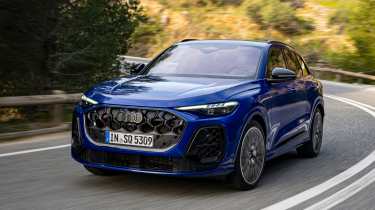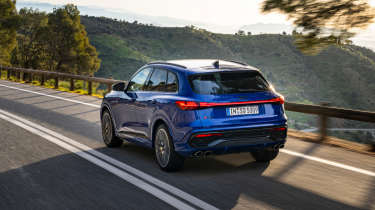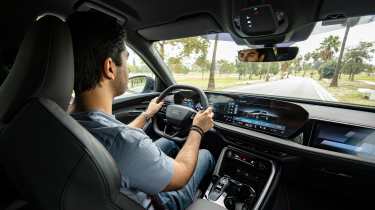Audi SQ5 2025 review – a quietly competent but uninvolving performance SUV
Audi’s latest SQ5 rides on a new PPC platform and packs a 362bhp V6 – it’s a well-rounded fast SUV but lacks the sparkle of the best
Audi has been on a roll with its performance cars lately. The latest RS3 is one of the most exciting hot hatches on sale, the recent RS4 Edition 25 years is one of our favourite fast estates, and the RS6 GT is brilliant and mad in equal parts. But Audi is steaming ahead into an era of new-generation models, and with that comes a fresh line-up of petrol-engined performance cars. The first was the new S5, which has now been joined by a box-fresh SQ5.
The SQ5 hasn’t been known for troubling the very sharp end of the hot SUV market (the original was the first diesel-powered S model, which says it all), but with Porsche shifting focus to its electric Macan, this latest version could be a worthy alternative to the ageing petrol Macan, which remains on sale. It also has BMW’s X3 M50 xDrive and Mercedes-AMG GLC 43 to deal with, and at its punchy £75,180 asking price, is within a whisker of a base Porsche Cayenne.
For that money you get an SUV that looks and feels like a new-generation product rather than an update of what’s gone before. That means softer, more flowing bodywork than the old car with similar design themes to the S5, and a cabin that features Audi’s newest tech and architecture. Fit and finish is tight and the material quality is high, but it’s a bit of a pixel fest, with a curved dual display panel on the dash combining with a third display for the passenger for over 37 inches of screen real estate. It’s a lot to take in while driving, and though it’s hard to fault the system’s crisp graphics and slick response times, you do miss having tactile physical switchgear for major controls, which Audi used to do exceptionally well. You also miss having proper buttons on the steering wheel. The new squared-off item has haptic controls on the spokes, and we lost count of how many times we mistakenly ramped up the radio volume while driving.
More reviews
Beneath that new skin is Audi’s new Premium Platform Combustion architecture, and a 3-litre petrol V6 assisted by Audi’s MHEV plus tech. The latter uses a 48-volt generator to recuperate energy to improve efficiency and support the engine with short bursts of up to 24bhp. All in you get 362bhp and 406lb ft of torque, and when you flex its muscles the SQ5 has a muted but satisfying V6 howl that has certain tones of Nissan 350Z about it, which is a pleasant surprise. It’s quick too, with a broad spread of torque and enough flexibility that you don’t need to flick through the seven-speed dual-clutch ‘box to keep it on song. Work it harder and there isn’t much in the way of top end fireworks to be enjoyed, but you can make effortless progress, the SQ5 covering ground with a satisfying calmness and refinement.
Edition 1 trim is the only spec offered from launch, coming with a host of standard kit including a Bang & Olufsen sound system, the aforementioned passenger display, a panoramic sunroof, 21-inch alloys and air suspension with adaptive dampers. Despite the big wheels the SQ5 rides well, absorbent over imperfections but with a firm edge to control the body. It doesn’t give the impression of a hardened sports SUV – it’s no less comfortable than a base Q5 – and it’s much, much more mild-mannered than something like an Alfa Stelvio Quadrifoglio.
The flip side is that there isn’t much fun to be had when you throw some more commitment at the SQ5. It’s stable and reassuring but restrained in its personality, and doesn’t reward you for tapping into its full performance. That isn’t necessarily a bad thing – Audi would argue that its RS models are geared towards that task – but it does feel like there’s room for the SQ5 to be that bit more entertaining. Fitting the Torque Splitter rear diff from the S3 would go some way to achieving this, we think, because the SQ5’s four-wheel drive system is very much geared towards pure traction rather than fun. Still, it is possible to carry decent speed along a technical road in the SQ5, placing it accurately and surging between corners on the torque from the V6. Push harder and you feel its 2040kg mass stressing the tyres and heaving through undulations but it’s not sloppy or unmanageable. The fundamental balance is quite neutral, too, rather than being completely nose-lead.
Dial things back and the SQ5 is a perfectly pleasant cruiser, the engine slipping smoothly into the background and the cabin being somehow more well isolated than lesser Q5s on smaller wheels. Comfort mode also calms the gearbox down, ironing out the awkward artificial kick you get when shifting in Dynamic, and you also notice the mild-hybrid system blending in to keep things quiet. When coasting the engine revs die and the SQ5 sails along, with a smooth handover back to the V6 when required. The 48-volt generator can even perform low-speed manoeuvres without help from the engine, and almost gives the impression of a full hybrid at times.
Rather than a hot SUV, the SQ5 feels more like a Q5 ‘plus’, with a sweeter and more effortless engine, more equipment, more handling ability and a little more refinement. Is that enough for an S-badged car that costs £75k? Probably not, but the SQ5 is still a rounded, effortless and tech packed SUV that would be pleasant to live with, even if it lacks the duality and edge of a proper performance model.
Price and rivals
At £75,180 the SQ5 is a chunk more expensive than BMW’s X3 M50 xDrive (£68,480), and £2k more than the Mercedes-AMG GLC 43. The Audi is less powerful than both, with the straight-six engined X3 offering 393bhp (albeit similar performance figures) and the Mercedes leading the pack with over 400bhp from a turbocharged four-pot.
The SQ5’s list price also opens up options from the class above, chiefly in the form of the Porsche Cayenne. In £76,000 base form it lags behind the Audi in performance terms, though, and needs certain dynamic and trim options to bring out its best. For similar money you can also buy a petrol Macan GTS, which is more powerful and more satisfying to drive than the Audi but a generation or two behind in terms of tech.







